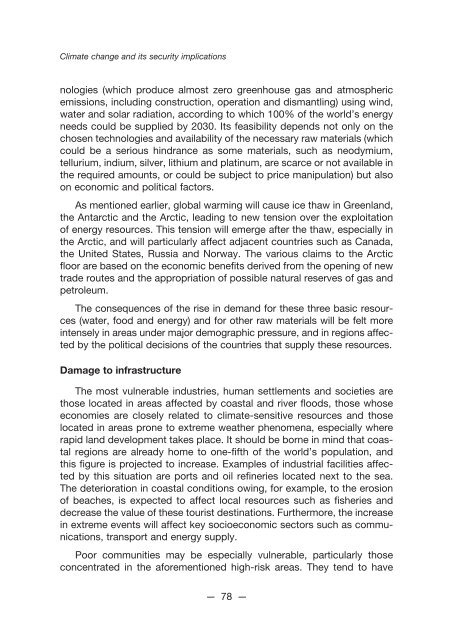Strategic Panorama 2009 - 2010 - IEEE
Strategic Panorama 2009 - 2010 - IEEE
Strategic Panorama 2009 - 2010 - IEEE
You also want an ePaper? Increase the reach of your titles
YUMPU automatically turns print PDFs into web optimized ePapers that Google loves.
Climate change and its security implications<br />
nologies (which produce almost zero greenhouse gas and atmospheric<br />
emissions, including construction, operation and dismantling) using wind,<br />
water and solar radiation, according to which 100% of the world’s energy<br />
needs could be supplied by 2030. Its feasibility depends not only on the<br />
chosen technologies and availability of the necessary raw materials (which<br />
could be a serious hindrance as some materials, such as neodymium,<br />
tellurium, indium, silver, lithium and platinum, are scarce or not available in<br />
the required amounts, or could be subject to price manipulation) but also<br />
on economic and political factors.<br />
As mentioned earlier, global warming will cause ice thaw in Greenland,<br />
the Antarctic and the Arctic, leading to new tension over the exploitation<br />
of energy resources. This tension will emerge after the thaw, especially in<br />
the Arctic, and will particularly affect adjacent countries such as Canada,<br />
the United States, Russia and Norway. The various claims to the Arctic<br />
floor are based on the economic benefits derived from the opening of new<br />
trade routes and the appropriation of possible natural reserves of gas and<br />
petroleum.<br />
The consequences of the rise in demand for these three basic resources<br />
(water, food and energy) and for other raw materials will be felt more<br />
intensely in areas under major demographic pressure, and in regions affected<br />
by the political decisions of the countries that supply these resources.<br />
Damage to infrastructure<br />
The most vulnerable industries, human settlements and societies are<br />
those located in areas affected by coastal and river floods, those whose<br />
economies are closely related to climate-sensitive resources and those<br />
located in areas prone to extreme weather phenomena, especially where<br />
rapid land development takes place. It should be borne in mind that coastal<br />
regions are already home to one-fifth of the world’s population, and<br />
this figure is projected to increase. Examples of industrial facilities affected<br />
by this situation are ports and oil refineries located next to the sea.<br />
The deterioration in coastal conditions owing, for example, to the erosion<br />
of beaches, is expected to affect local resources such as fisheries and<br />
decrease the value of these tourist destinations. Furthermore, the increase<br />
in extreme events will affect key socioeconomic sectors such as communications,<br />
transport and energy supply.<br />
Poor communities may be especially vulnerable, particularly those<br />
concentrated in the aforementioned high-risk areas. They tend to have<br />
— 78 —

















